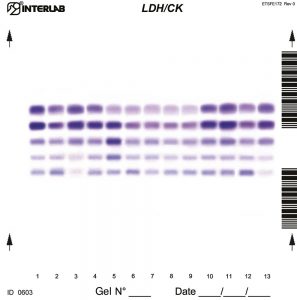
| REF | DESCRIPTION | SAMPLES PER GEL | TEST PER KIT |
|
|
|---|---|---|---|---|---|
| SRE612K | LDH ISOENZYMES ELECTROPHORESIS KIT | ۱۳ | ۱۳۰ |
The LDH isoenzymes kit SRE612K is intended for the qualitative and quantitative determination of the LDH isoenzymes by electrophoresis on agarose gel and specific enzymatic detection. Lactate dehydrogenase (LDH) is present in all human tissues and cells, with the greatest concentrations in liver, heart, skeletal muscle and kidney. Normal serum LDH isoenzyme profiles are the result of normal tissue breakdown.
There are five different LDH isoenzymes that can be detected in serum. In standard LDH isoenzymes electrophoretic patterns five bands are observed, identified according to their electrophoretic mobility from anode to cathode as LDH 1, LDH 2, LDH 3, LDH 4, and LDH 5. Thanks to the new Easy Interlab G26 & Pretty Interlab the LDH procedure is extremely fast and user friendly. The kits have been designed for use with the fully automated instruments Easy Interlab G26 & Pretty Interlab.

Reagent Preparation:
All reagents are ready to use, only the staining reagent must be reconstituted with 1.2 ml of buffer.
Sample Preparation:
Fresh neat serum samples.
Sample Storage & Stability:
Serum: Fresh serum samples. If needed, 2 days at 15 to 30°C or at 2 to 8 °C
Lactate dehydrogenase (LDH, E. C. 1.1.1.27.) is an intracellular enzyme found in human tissues, such as skeletal muscle, heart, liver and kidneys. The molecule is composed of two subunits, H and M, that are assembled to give a tetramer. Different qualitative association of the subunits results in the formation of five different LDH molecules called ‘isoenzymes’ or ‘isoforms’, that can be separated by electrophoresis on agarose gel. According to the electrophoretic mobility five bands can be separated. The LDH1 isoform, found in heart muscle, is composed of four H subunits and is the most anodic, while the most cathodic isoform is LDH5 that is found in skeletal muscle and liver, and is composed of four M subunits. Isoenzymes of intermediate mobility, LDH2, LDH3 and LDH4, are found in varying degrees in many tissues. Quantitation of these fractions provides useful information on the identification of specific tissue or organ damage.
Electrophoresis of LDH isoenzymes is an important test for the diagnosis of myocardial and liver damages. Marked increase of LDH1 is observed after myocardial infarction (MI), resulting in a LDH1/LDH2 ratio greater than 1 (‘flipped LDH’). LDH5 is an excellent indicator of active liver damage.
Interfering substances :
Do not use hemolyzed samples and uremic sera.
Some drugs and inhibitors (like oxalate) affect the activity of LDH.
Repeated freezing and thawing of samples destroys LDH activity
